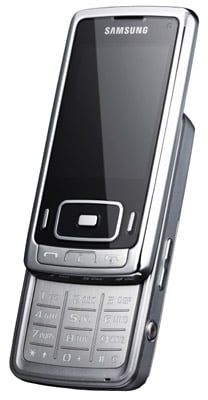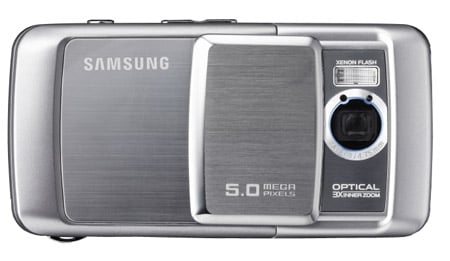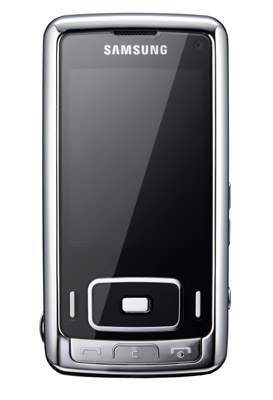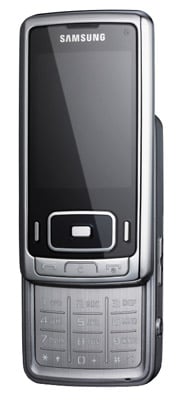Original URL: https://www.theregister.com/2008/01/17/review_samsung_sgh_g800/
Samsung SGH-G800 5Mp cameraphone
G600 + 3G = G800
Posted in Personal Tech, 17th January 2008 12:02 GMT
Review Samsung has put itself in the frame as a serious cameraphone contender with the SGH-G800, a five-megapixel cameraphone sporting a 3x optical zoom plus face-detection and autofocus technology.

Samsung's SGH-G800: a serious contender?
Samsung has already hit the five-megapixel cameraphone mark in Europe with its stylish G600 - reviewed here. The G600 squeezed its camera into a standard frame, but the G800 has been built from the ground up with the camera as the key element of the phone. That said, it’s also equipped with the latest 3G HSDPA connectivity, meaning maximum download and surfing speeds of up to 7.2Mb/s if your mobile network operator supports it.
Unlike the 2.5G G600, all the regular 3G download and streaming features are available on the G800, plus face-to-face video calling courtesy of a secondary camera above the display.
With internal user memory of up to 110MB there’s enough storage for plenty of high-resolution images, or a few albums’ worth of MP3s. Swappable Micro SD cards of up to 4GB are also supported if you want a capacity boost. There's an FM radio with RDS along with the digital music player.
The inclusion of the internal 3x optical zoom mechanism inside the phone’s body results in a chunky device, a departure from Samsung's recent skinny models. Its official dimensions are 101.5 x 52 x 18.8mm, though this doesn’t seem to include the sliding lens cover on the back, which adds a few millimetres more to the G800's overall girth. Weighing in at 129g, the G800 is slightly heavier than the comparably-sized Nokia N95.
While the bulk-factor hasn’t stopped the N95 hitting the bestseller list, the G800 doesn’t have quite the same heavyweight specs – such as built-in GPS and dedicated music controls - even if it does have that optical zoom edge.
The design combines the looks of a sharp mobile and a digital camera. It has a large 2.4in, 320 x 240, 262,144-colour display up front with a black and chrome surrounding, while the back sports a smart brushed metal-style finish on plastic.
Thankfully, Samsung hasn’t overdone it with the controls, using a straightforward central navigation control arrangement with flanking vertically-aligned soft-menu keys. Call, end and clear keys are lined up in minimalist fashion at the bottom.

Slim, but heavier than the Nokia N95
The main menu system is laid out in a grid of icons which can be switched to a list, if you prefer. From here you can select sub-menus to explore features, apps and settings. The navigation pad can be configured as quick access shortcuts. The efficient sliding numberpad that slips out from under the body is reassuringly solid. The keypad is a smooth all-in-one affair, with buttons flush on the brushed metal-look pad but still responsive enough when pushed.
On one side of the phone is the Micro SD memory card slot, next to the G800’s charger/earphones socket. Yes, Samsung opts for a dual-function proprietary headphone socket rather than a standard headphone socket, so sadly options for replacing the in-box headset are limited unless you go down the stereo Bluetooth route.
On the other side, there’s the familiar camera activation button, though you need to slip open the slide cover to fire up the camera. Holding the phone horizontally, the zoom control/volume buttons are positioned near to the camera button, inviting right-handed zooming as well as shooting.
That heftiness comes into its own when holding the G800 as a camera - it feels substantial and well-balanced, unlike some slimline cameraphones, which feel like they’re about to tumble out of your hands.
Slip back the lens cover in standby and you’re presented with a digital camera style user-interface that matches up the external camera cosmetics.
The tidy icon interface brings up some handy controls at the touch of the navigation pad - this becomes a four-way switch for the macro mode, flash control, timer and on-screen graphics mode. Other control icons are lined up on the top of the screen, accessed by pressing a soft-menu key and scrolling with the nav-pad.
Unusually for a cameraphone, the G800 has an anti-shake image stabilisation option, though it's hidden away in the settings sub-menu. Even more unusually, Samsung has added a face-detection autofocus option. As well as being able to use standard autofocus, with the camera button acting as a two-step shutter control, if you turn face detection on, the camera will automatically adjust other settings to optimise people shots. This works remarkably well, even in so-so lighting conditions.
While bright lighting conditions naturally help most cameras, the G800 features Samsung’s Wide Dynamic Range technology that’s designed to improve results when backlighting or varying light sources would otherwise adversely affect the exposure of subjects.

The back looks like a standalone digital camera
There are a range of settings to tweak the default auto mode: four additional white balance settings; exposure control; and options to regulate contrast, saturation and sharpness. You can change ISO settings for tweaking light sensitivity and even adjust exposure metering.
Other, more commonplace cameraphone settings, such as multi-shot and panoramic shooting; adding frames and effects; and mosaic shooting, are offered. Then there’s the timer and macro mode to choose from, plus a red-eye reduction option in the flash menu. That’s no bad set of options for a phone.
The results from the camera are exceptional - you can achieve superbly-detailed shots, with accurate colour rendition, and it copes impressively with tricky lighting. Shots look good printed as well as on a computer screen, and there's no great delay in processing images to frustrate you.
Photos and videos can also be uploaded to a wide variety of blogs and community websites – including Flickr, Facebook and YouTube – thanks to pre-loaded link to the ShoZu service. A ShoZu account can be created on the phone, while you can configure your account online to upload content to your preferred sites.
The video capabilities of the G800 aren’t on a par with its stills quality, however. It shoots at maximum QVGA resolution (320 x 240), so while they look decent on the phone they’re not particularly impressive on a computer or TV.
The G800 looks to impress musically, too. Its player app can handle MP3, MIDI, ACC, ACC+, eAAC+, WMA and ASF files, and categorises tracks in the usual way. Samsung also trumpets the phone’s internal amplifier, developed by Bang & Olufsen.

B&O amplifier on board
All well and good, but by including a decidedly mediocre set of earphones in the box, Samsung certainly doesn’t make the most of this feature. Audio performance through these is average.
Getting tunes to the phone is straightforward. The G800 can be synced with Windows Media Player 11 via USB cable, or you can use Samsung's own PC Studio software. You can also copy files directly to the phone's memory card by setting the phone to mass-storage mode and dropping tracks from your PC.
You can download tracks over the air to the phone too, if your operator offers a compatible music service. Its 3G HDSPA connectivity makes this a quick and painless experience.
When it comes to surfing, the G800's Access NetFront v3.4 web browser isn’t as sophisticated as some of the latest smartphone browsers. By default, it fits pages to the screen's width, and it's a bit hit and miss. Some pages don’t work well like this but complex sites can come out unsatisfyingly mixed up, though you can opt for a more satisfactory quick-loading full-page views. Flash isn’t supported here, however.
The G800 also supports RSS feeds for grabbing regular updates from your favourite websites automatically.
The G800 has a regulation email client and a document viewer for attachments, including Word, Excel, PowerPoint and PDFs. Samsung also includes the usual suite of personal information management tools.
Our review sample didn’t have any games loaded up, but the phone supports Java downloads and a link to download them - along with ringtones, themes, wallpapers and so on - from Samsung’s Fun Club mobile internet site.

The controls are nicely understated
The G800’s impressive picture-taking performance should mean users will keep it busy taking and showing off its high quality snaps. Of course, that inevitably has an impact on battery life, as will using the music or video player regularly. Samsung says the G800 should provide a minimum of up to 200 minutes' talk time or 220 hours in standby mode, though these figures don’t include use of its more power-hungry features and display.
Making calls, the G800 put in a commendably fine, consistent performance, with clear, top-class sound quality at both ends throughout calls.
Verdict
The G800 isn't quite ready to replace a dedicated digital camera just yet. The autofocus system is up there with the best mobiles but isn’t as sophisticated as one you'll find in a decent camera. The bulk may put off some buyers, but size-sacrifices are necessary for its high-end camera qualities.
Nonetheless, the G800 is attractive to look at and has a solid if unexceptional set of high-end feature phone functions. Its high-speed 3G HSDPA connectivity is a bonus if you’re keen on downloading content or browsing, although here the browser’s not the best we’ve seen to complement the added speed.